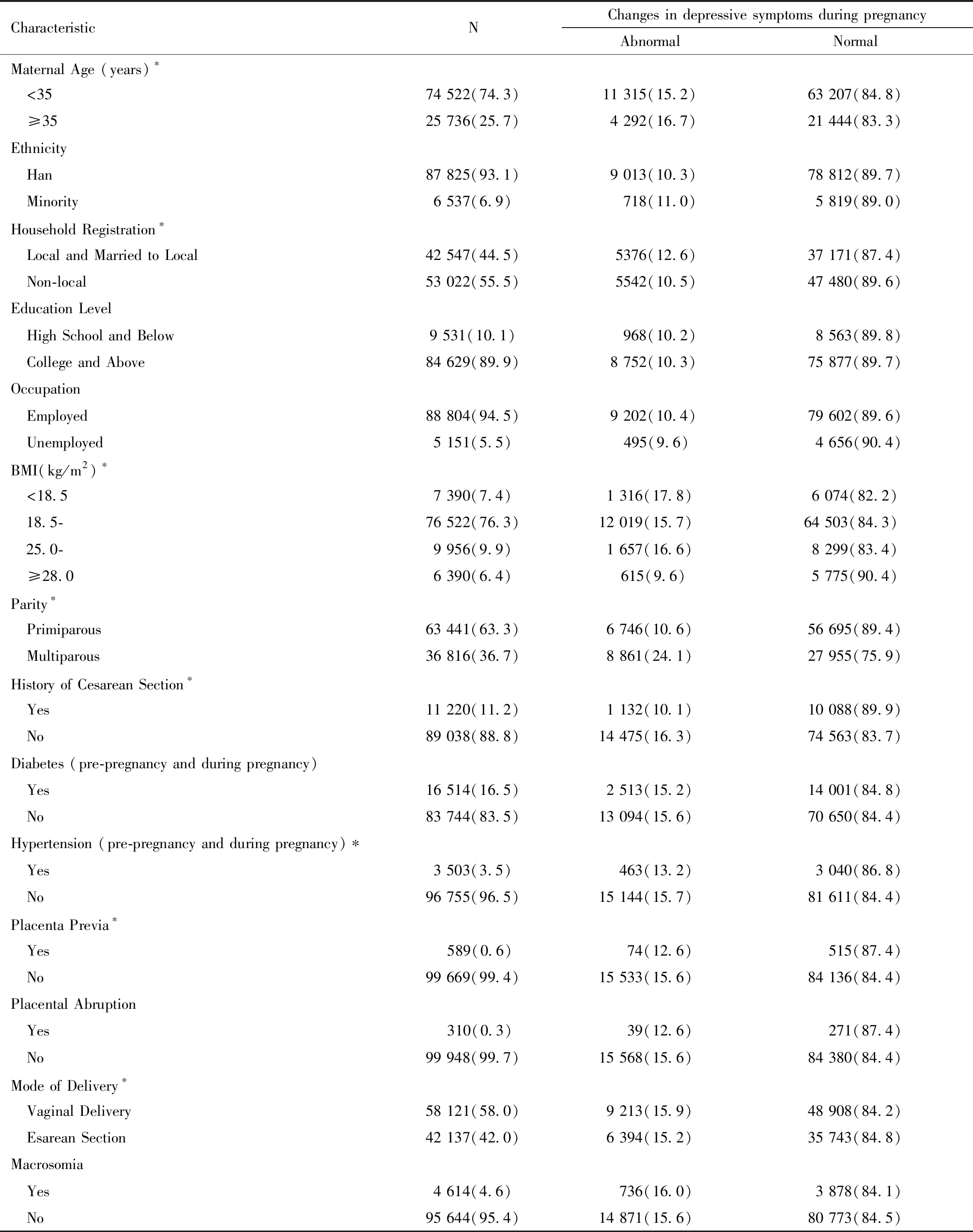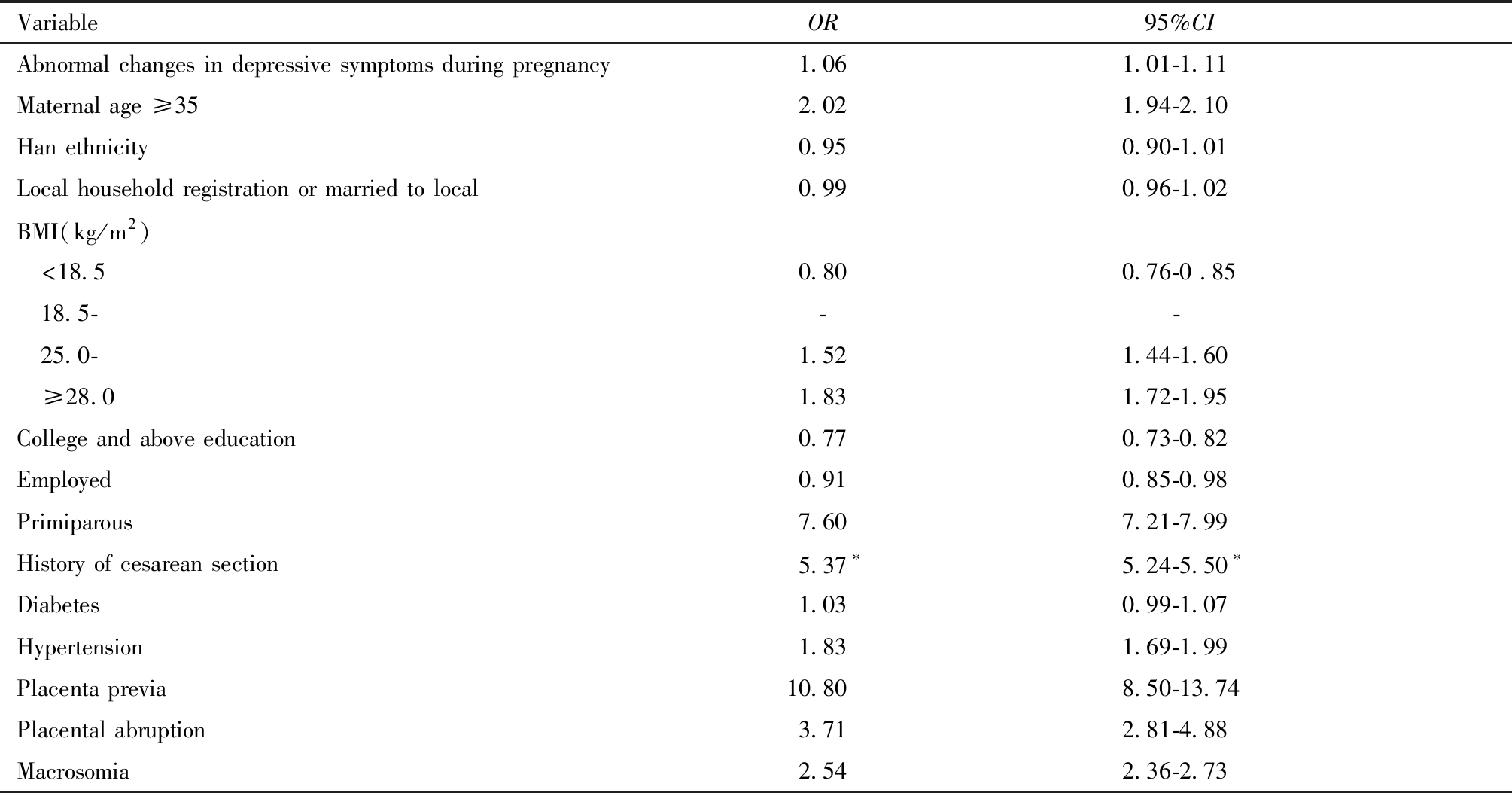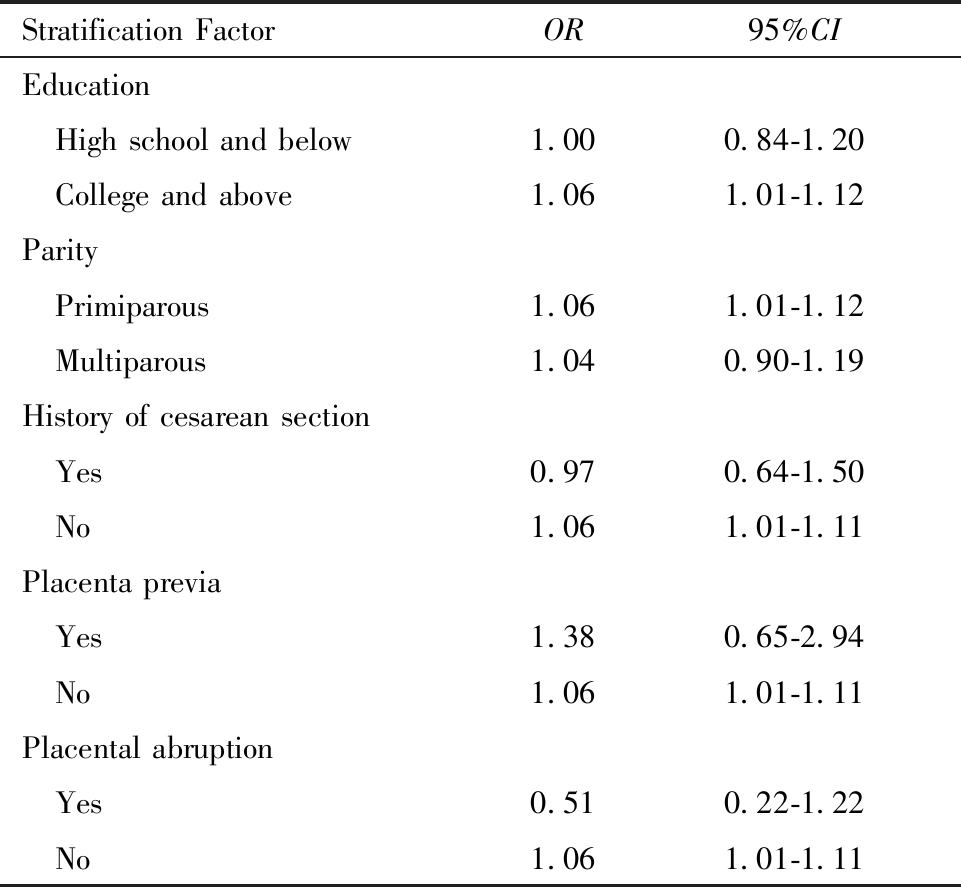近年来全球范围内剖宫产率的居高不下已成为一个备受关注的问题[1]。2019年中国剖宫产率高达43.4% [2]。尽管剖宫产在解决难产、胎儿窘迫等紧急情况下具有不可替代的作用,但过高的剖宫产率不仅增加了医疗资源的消耗,还可能对母婴健康产生负面影响[1]。在影响分娩方式的因素中,年龄、体质指数(body mass index,BMI)、产次、剖宫产史、高血压、前置胎盘等医学因素占据重要地位,此外,社会文化、家庭观念、医患关系等社会因素也对分娩方式的选择产生影响[3-5]。
孕期抑郁症状作为孕妇心理健康的一个重要方面[6],可以显著影响分娩方式的选择[7-8]。当孕妇处于抑郁状态时,她们可能会因为恐惧、焦虑或对自然分娩过程的不信任,而更倾向于选择剖宫产。这种基于个人心理状态而非纯医学指征的选择,虽然在表现形式上可能与社会因素(如家庭观念、医患关系等)相似,但其根源在于孕妇的心理健康状况。因此,在讨论分娩方式选择的影响因素时,我们不仅要关注传统的社会因素,还要充分认识到孕期抑郁症状等心理健康因素所可能带来的复杂影响。
然而,目前的研究主要集中在孕期某一特定时点的抑郁症状对分娩方式的影响,而关于孕期抑郁症状变化轨迹对分娩方式影响的研究相对较少[9]。因此,本研究通过动态观察孕期抑郁症状的变化轨迹,探讨其对分娩方式的影响。在分析中,控制了年龄、BMI、产次、剖宫产史、高血压、前置胎盘等医学因素,以揭示孕期抑郁症状与剖宫产率之间的潜在关系。通过这项研究,旨在为降低剖宫产率、优化分娩方式选择提供科学依据,同时也有助于提高孕期心理健康水平,促进母婴健康。
对象与方法
一、研究对象
在北京市领取母子健康手册的孕妇分别于孕早期(妊娠13+6周内)及孕中晚期(妊娠14+0周-分娩前)通过“北京妇幼健康服务”公众号使用患者健康问卷抑郁量表(Patient Health Questionnaire-9, PHQ-9)进行心理健康评估,评估结果实时上传至北京市妇幼信息系统中。数据来源于北京市妇幼信息系统中分娩日期为2023年1月1日—2023年12月31日的孕产妇,研究对象需满足以下条件:分娩时间在2023年内、分娩孕周≥28周、单胎、无胎儿出生缺陷,并且在这两个时期均进行了心理健康评估。多胎及有胎儿出生缺陷的孕产妇则被排除在研究之外。
二、方法
心理健康评估采用PHQ-9,该量表具有良好的信度和效度,在国内外广泛应用于孕产妇抑郁症状筛查[10-11]。该量表包含9个项目,具体内容为:(1)对日常活动失去兴趣或乐趣;(2)感到沮丧、情绪低落或绝望;(3)入睡困难、睡眠过多或睡眠不安;(4)感到疲乏或缺乏精力;(5)食欲不振或暴饮暴食;(6)对自己感到不好,认为自己是个失败者或让家人失望;(7)难以集中注意力,做事时容易分心;(8)动作或说话速度变慢,或者相反,变得异常活跃或坐立不安;(9)对自己或他人造成伤害的念头。参与者根据过去两周内的情况,对每一项进行评分,评分范围为0(完全没有)到3(几乎每天都有),总分为0~27分。根据评分规则,总分≥5分且最后一项不为0被视为结果异常。
通过“北京妇幼健康服务”公众号,心理健康评估共进行了两次,分别在孕早期(妊娠13+6周内)和孕中晚期(妊娠14+0周-分娩前)均填写PHQ-9量表,评估结果实时上传至北京市妇幼信息系统进行数据存储和管理。
根据两次评估结果确定孕期抑郁症状的变化轨迹,我们将孕产妇分为两组:正常组和异常组。正常组包括孕早期和孕中晚期评估结果均正常(全程正常组),或孕早期出现异常但孕中晚期恢复正常的孕产妇(转变为正常组);异常组包括孕早期心理健康评估结果正常但孕中晚期出现异常(转变为异常组),或孕早期和孕中晚期均出现异常者(全程异常组)。
三、统计学处理
使用stata14.0软件进行数据分析。计数资料以例数(百分数)表示,即[n(%)];组间比较采用χ2检验。多因素分析采用Logistic回归分析。在分析过程中,针对完全分离现象(如剖宫产史与分娩方式的高度相关性),采用Firth Logistic Regression进行校正,以避免过度估计OR值。统计检验中,P<0.05为差异有统计学意义。
结 果
一、基本情况
本研究纳入了100 258名孕产妇,正常组84 386人(84.2%),异常组15 872(15.8%)人。正常组中全程正常组67 575人(80.1%)、转变为正常组16 811人(19.9%);异常组中全程异常组9 053人(57.0%)、转变为异常组6 819人(43.0%)。分娩方式比较结果显示,转变为异常组剖宫产率最高(43.0%),全程正常组次之(42.3%),转变为正常组再次之(42.0%),而全程异常组选择剖宫产的比例最低(39.6%)。
大部分研究对象(74.3%)分娩年龄小于35岁,93.1%为汉族。大学及以上学历的孕产妇占89.9%,94.5%的孕产妇在孕期保持有职业。BMI方面,76.3%的孕产妇处于正常范围内,初产妇占63.3%。分娩方式中,阴道分娩的占比(58.0%)略高于剖宫产(42.0%),见表1。
表1 研究对象一般特征及孕期抑郁症状变化情况[n(%)]
Table 1 Characteristics of the study subjects and changes in depressive symptoms during pregnancy [n(%)]

*Compared between groups, P<0.05
CharacteristicNChanges in depressive symptoms during pregnancyAbnormalNormalMaternal Age (years)∗ <3574 522(74.3)11 315(15.2)63 207(84.8) ≥3525 736(25.7)4 292(16.7)21 444(83.3)Ethnicity Han87 825(93.1)9 013(10.3)78 812(89.7) Minority6 537(6.9)718(11.0)5 819(89.0)Household Registration∗ Local and Married to Local42 547(44.5)5376(12.6)37 171(87.4) Non-local53 022(55.5)5542(10.5)47 480(89.6)Education Level High School and Below9 531(10.1)968(10.2)8 563(89.8) College and Above84 629(89.9)8 752(10.3)75 877(89.7)Occupation Employed88 804(94.5)9 202(10.4)79 602(89.6) Unemployed5 151(5.5)495(9.6)4 656(90.4)BMI(kg/m2)∗ <18.57 390(7.4)1 316(17.8)6 074(82.2) 18.5-76 522(76.3)12 019(15.7)64 503(84.3) 25.0-9 956(9.9)1 657(16.6)8 299(83.4) ≥28.06 390(6.4)615(9.6)5 775(90.4)Parity∗ Primiparous63 441(63.3)6 746(10.6)56 695(89.4) Multiparous36 816(36.7)8 861(24.1)27 955(75.9)History of Cesarean Section∗ Yes11 220(11.2)1 132(10.1)10 088(89.9) No89 038(88.8)14 475(16.3)74 563(83.7)Diabetes (pre-pregnancy and during pregnancy) Yes16 514(16.5)2 513(15.2)14 001(84.8) No83 744(83.5)13 094(15.6)70 650(84.4)Hypertension (pre-pregnancy and during pregnancy)∗ Yes3 503(3.5)463(13.2)3 040(86.8) No96 755(96.5)15 144(15.7)81 611(84.4)Placenta Previa∗ Yes589(0.6)74(12.6)515(87.4) No99 669(99.4)15 533(15.6)84 136(84.4)Placental Abruption Yes310(0.3)39(12.6)271(87.4) No99 948(99.7)15 568(15.6)84 380(84.4)Mode of Delivery∗ Vaginal Delivery58 121(58.0)9 213(15.9)48 908(84.2) Esarean Section42 137(42.0)6 394(15.2)35 743(84.8)Macrosomia Yes4 614(4.6)736(16.0)3 878(84.1) No95 644(95.4)14 871(15.6)80 773(84.5)
二、孕期抑郁症状变化的单因素分析
单因素分析显示,在孕产妇基本特征方面,年龄≥35岁、本地户籍或外嫁至京、BMI过低或超重的孕妇在孕期抑郁症状变化异常的比例较高。孕产期特征方面,经产妇、无剖宫产史、未患高血压以及无前置胎盘的孕妇呈现较高的孕期抑郁症状变化异常比例。见表1。
三、分娩方式的单因素分析
单因素分析显示,阴道分娩和剖宫产在孕期抑郁症状变化异常的比例上存在显著差异,见表1。阴道分娩孕产妇中,孕期抑郁症状变化异常比例(15.9%)略高于剖宫产孕产妇(15.2%),提示分娩方式可能与孕期抑郁症状的变化轨迹相关,尽管差异较小。为了验证这一关联并排除其他潜在混杂因素,需要进行进一步的多因素分析。
四、Logistic回归分析
Logistic回归分析结果表明,在控制了其他潜在混杂因素后,孕期抑郁症状变化异常与分娩方式之间存在显著相关性。具体来说,孕期抑郁症状变化异常的孕产妇选择剖宫产的几率增加(OR=1.06,95%CI:1.01~1.11)。其他因素中,高龄、BMI、受教育程度、职业、产次、剖宫产史、高血压、前置胎盘、胎盘早剥以及巨大儿等也与分娩方式显著相关。然而,民族、户籍以及糖尿病与分娩方式之间的差异无统计学意义,见表2。
表2 分娩方式影响因素的Logistic回归分析
Table 2 Logistic regression analysis of factors influencing delivery mode

*The adjusted result after correcting for the complete separation phenomenon
VariableOR95%CI Abnormal changes in depressive symptoms during pregnancy1.061.01-1.11Maternal age ≥352.021.94-2.10Han ethnicity0.950.90-1.01Local household registration or married to local0.990.96-1.02BMI(kg/m2) <18.50.800.76-0 .85 18.5-- - 25.0-1.521.44-1.60 ≥28.01.831.72-1.95College and above education0.770.73-0.82Employed0.910.85-0.98Primiparous7.607.21-7.99History of cesarean section5.37∗ 5.24-5.50∗Diabetes1.030.99-1.07Hypertension1.831.69-1.99Placenta previa10.808.50-13.74Placental abruption3.712.81-4.88Macrosomia2.542.36-2.73
五、Logistic回归分层分析
为了更全面地探究孕期抑郁情绪变化对分娩方式的影响,并考虑到多因素分析与单因素分析结果的差异,进行了分层 Logistic 回归分析(见表3)。纳入了所有未分层时具有显著性差异的因素,并考虑了他们对分娩方式的影响。分层分析结果表明,不同因素下孕期抑郁症状变化与选择剖宫产之间存在着不同程度的关联。
表3 不同分层孕产妇孕期抑郁情绪变化异常对分娩方式影响因素的Logistic回归分析
Table 3 Logistic regression analysis of the influence of abnormal changes in antenatal depressive symptoms on delivery mode among different stratified pregnant women

Stratification FactorOR95%CIEducation High school and below1.000.84-1.20 College and above1.061.01-1.12Parity Primiparous1.061.01-1.12 Multiparous1.040.90-1.19History of cesarean section Yes0.97 0.64-1.50 No1.061.01-1.11Placenta previa Yes1.380.65-2.94 No1.061.01-1.11Placental abruption Yes0.510.22-1.22 No1.061.01-1.11
具体而言,对于受教育程度为大学及以上的孕妇,孕期抑郁症状变化异常显著增加选择剖宫产(OR=1.06,95%CI:1.01~1.12)。在初产妇中,孕期抑郁症状变化异常者选择剖宫产的概率显著增加(OR=1.06,95%CI:1.01~1.12)。而对于无剖宫产史、无前置胎盘以及无胎盘早剥的孕妇,孕期抑郁症状变化异常与选择剖宫产之间也呈现显著关联,OR及95%CI分别为 1.06(1.01~1.11)、1.06(1.01~1.11)、1.06(1.01~1.11)。
讨 论
一、北京市孕期抑郁症状变化情况
文献显示,中低收入国家产前抑郁症的汇总患病率为26.3%[12],中国内地产前抑郁症患病率为19.7%[13]。本研究发现,北京市孕期抑郁症状变化异常的比例为15.8%,显著低于上述数据,这种差异可能与北京市相对完善的孕期保健服务、较高的教育水平和良好的社会支持体系有关。此外,本研究主要关注孕期抑郁症状变化异常的比例,而不是某个特定时点的患病率,也可能解释了北京市较低的比例。
文献显示,产前心理干预对产前和产后抑郁症均有显著影响[14]。然而,本研究中,尽管在正常组中有16 811名孕妇从异常转为正常,但在异常组中,仍有9 053名孕妇全程保持异常,另有6 819名孕妇从正常转为异常。这表明,当前的产前心理干预可能尚不充分。因此,在孕期保健工作中,应更加关注孕妇的心理健康,确保及时干预心理异常,使心理干预成为孕期保健的核心环节。
二、孕期抑郁症状变化对分娩方式的影响
本研究发现,孕期抑郁症状变化异常的孕妇更倾向于选择剖宫产作为分娩方式。这可能是因为抑郁症状降低了孕妇对自然分娩的信心[15],进而更倾向于选择剖宫产以规避潜在的分娩风险。同时,精神心理因素作为影响分娩的四大因素之一,抑郁症状还可能影响孕妇的生理机能,如宫缩力和产道扩张能力,从而增加自然分娩的难度。这一结果提示了医务人员应关注孕妇的心理变化轨迹,及时发现并处理心理问题,为孕妇提供全方位的支持和关爱,帮助她们缓解抑郁症状,增强自信心,从而降低剖宫产率并促进自然分娩。
进一步的分层分析揭示了孕期抑郁症状变化对分娩方式的影响在不同亚群中的差异。高学历和初产妇更容易受到孕期抑郁症状的影响,这可能是因为高学历的孕妇对孕期健康知识和心理健康问题有更深入的了解[16],而初产妇在面对分娩时缺乏经验,更容易感到焦虑和不安[17]。因此,当她们经历抑郁症状变化异常时,可能更倾向于选择剖宫产以避免潜在的风险或获得更快的分娩过程和更少的痛苦。这提示在孕期保健工作中,应特别关注这些人群的心理健康状况,为其提供个性化的心理支持和干预措施。
另外,在分层分析中,无剖宫产史、无前置胎盘及无胎盘早剥的孕妇也显示出孕期抑郁症状变化异常,更倾向于选择剖宫产作为分娩方式。这一结果进一步强调了在控制了这些潜在因素后,孕期抑郁症状变化异常仍与剖宫产选择呈现出显著的相关性。表明孕期异常变化的心理因素在分娩方式决策中发挥着独特作用。
尽管本研究发现了孕期抑郁症状变化对分娩方式的影响,未来的研究可以进一步探讨其他潜在的影响因素和亚群差异,以更全面地理解孕期心理健康与分娩方式之间的关系,并为孕期保健工作提供更有效的干预策略。
综上所述,本研究深入探讨了孕期抑郁症状的变化轨迹对分娩方式的影响,并发现孕期抑郁症状变化异常的孕妇更倾向于选择剖宫产。特别是在受教育程度高、初产妇以及无剖宫产史、无前置胎盘和无胎盘早剥的孕妇中,影响更为显著。这些发现突显了孕期心理健康对分娩方式的重要影响,建议在孕期保健工作中加强对孕妇心理健康的关注和提供及时有效的心理支持和干预措施。
1 国家产科专业医疗质量控制中心,中华医学会围产医学分会.剖宫产手术专家共识(2023).中华妇产科杂志,2024,59:14-21.
2 陈练,石慧峰,魏瑗,等.2019年度全国产科专业医疗服务与质量安全报告分析.中国卫生质量管理,2022,29:前插1,1-5,16.
3 黄谱,丁洁,李雪兰.降低剖宫产率策略细节与并发症防控.中国计划生育和妇产科,2022,14:13-15,19.
4 黄巧,曹奕,杨蓉.重庆市2067例产妇非医学指征剖宫产现状及影响因素.重庆医学,2023,52:137-141.
5 徐晓明,王傲,李玉岩.大连市初产妇及经产妇剖宫产率及剖宫产指征分析.现代妇产科进展,2023,32:438-441.
6 Zhang L,Wang L,Cui S,et al.Prenatal depression in women in the third trimester:prevalence,predictive factors,and relationship with maternal-fetal attachment.Front Public Health,2020,8:602005.
7 Khanghah AG,Khalesi ZB,Afagh HR.The importance of depression during pregnancy.JBRA Assist Reprod,2020,24:405-410.
8 Zhang ZY,Yu JJ,Zeng WT,et al.Association between antenatal depression and adverse perinatal outcomes:a prospective cohort study.J Affect Disord,2023,323:490-495.
9 Miller ES,Saade GR,Simhan HN,et al.Trajectories of antenatal depression and adverse pregnancy outcomes.Am J Obstet Gynecol,2022,226:108.e1-108.e9.
10 中华医学会妇产科学分会产科学组.围产期抑郁症筛查与诊治专家共识.中华妇产科杂志,2021,56:521-527.
11 Screening anddiagnosis of mental health conditions during pregnancy and postpartum:ACOG Clinical Practice Guideline No.4.Obstet Gynecol.2023,141:1232-1261.
12 Roddy A,Gordon H,Lindquist A,et al.Prevalence of perinatal depression in low-and middle-income countries:a systematic review and meta-analysis.JAMA Psychiatry,2023,80:425-431.
13 Nisar A,Yin J,Waqas A,et al.Prevalence of perinatal depression and its determinants in China Mainland:A systematic review and meta-analysis.J Affect Disord,2020,277:1022-1037.
14 Yasuma N,Narita Z,Sasaki N,et al.Antenatal psychological intervention for universal prevention of antenatal and postnatal depression:A systematic review and meta-analysis.J Affect Disord,2020,273:231-239.
15 Cho H,Ahn S.Do childbirth confidence,prenatal depression,childbirth knowledge,and spousal support influence childbirth fear in pregnant women? Korean J Women Health Nurs.2020,26:358-366.
16 王勋,马宁,姚丰菊,等.河南、广东、内蒙古三地居民心理健康知识知晓率调查.中国心理卫生杂志,2022,36:764-768.
17 郭丽,焦悦,孙红雯,等.配偶同步激励式心理干预联合产房分娩核查对自然分娩初产妇的影响.国际精神病学杂志,2023,50:1095-1098.